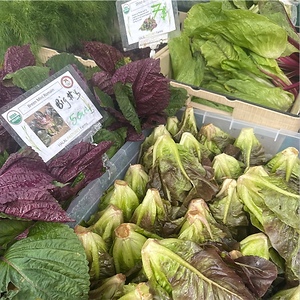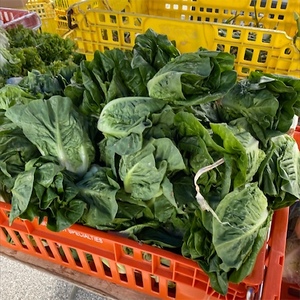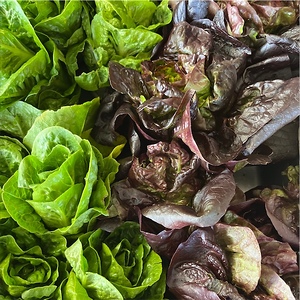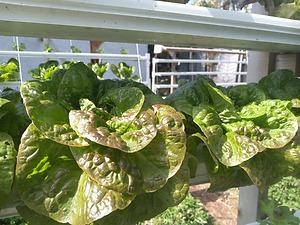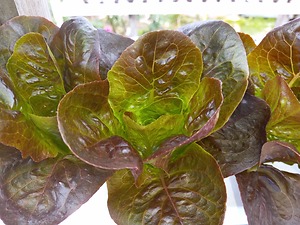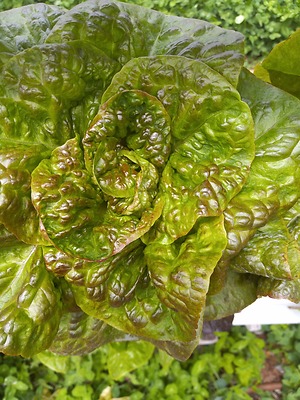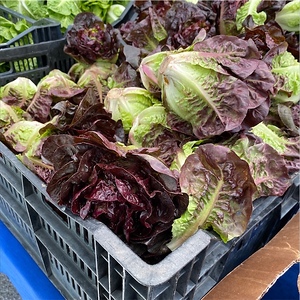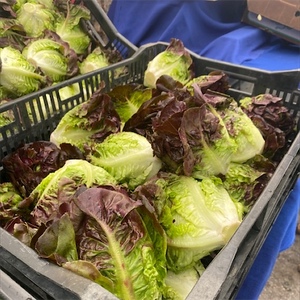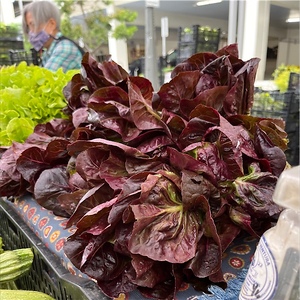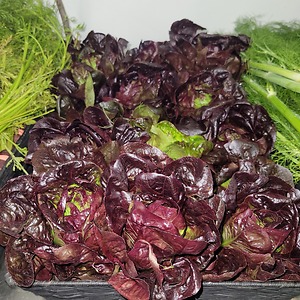

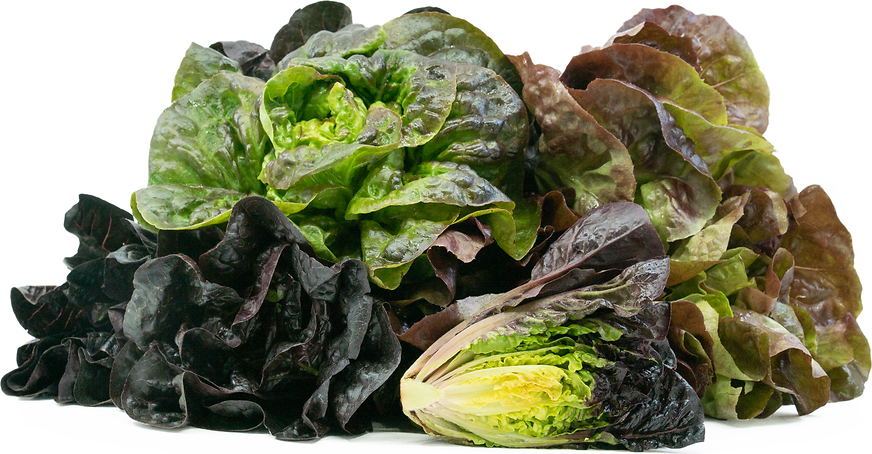
Red Gem Lettuce
Estimated Inventory, 30 ct : 0
Description/Taste
Red Gem lettuce varieties are generally small to medium in size, depending on the specific cultivar and growing conditions, and have slightly elongated heads comprised of densely packed leaves. The leaves grow in layered, furled rosettes and are condensed at the lettuce’s base, expanding, fanning, and loosening at the top of the head, showcasing the ruffled leaf edges. Red Gem lettuce varieties vary in color, appearing in shades of dark purple, maroon, to variegated shades of red and green. Some varieties may also have a pale green base and core, darkening into green hues blushed with copper, red, to red-brown patches. The leaves also have a crinkled, textured, and semi-glossy surface with a broad, thick, wavy, and pliable nature, connecting into a crunchy, aqueous stem. Red Gem lettuce varieties have a crisp, tender, and succulent consistency. The leaves bear a delicately sweet flavor combined with nutty and vegetal nuances.
Seasons/Availability
Red Gem lettuce is available year-round.
Current Facts
Red Gem lettuce, botanically classified as Lactuca sativa, is a general descriptor for several lettuce varieties belonging to the Asteraceae family. The wavy, textured, and colorful, loose-forming heads are a unique type of lettuce cultivated commercially and in home gardens for use as an everyday salad green. There are many different varieties of Red Gem lettuce grown worldwide, and the heads thrive in compact spaces, allowing them to be closely planted. Popular cultivars of Red Gem lettuce include Marciano, Cegolaine, Rosaine, Ruby Gem, Pomegranate Crunch, Truchas, Ezbruke, Breen, and Suntred. Some of these varieties, specifically Marciano and Cegolaine, are modern cultivars favored for their sweet flavor, densely compact heads, and unique coloring. Growers also value these varieties for their slow-bolting nature and resistance to disease. Chefs select Red Gem lettuce varieties for their versatility in culinary preparations, utilized raw and cooked, and the greens provide a refreshingly mild, sweet, and vegetal flavor embodied in a delicate, tender crunch.
Nutritional Value
Red Gem lettuce is a source of vitamin C to strengthen the immune system while reducing inflammation, calcium to build strong bones and teeth, and iron to develop the protein hemoglobin for oxygen transport through the bloodstream. The greens also provide some anthocyanins, pigmented compounds in the leaves that contribute anti-inflammatory properties and protect the cells against free radical damage, vitamin K to assist in faster wound healing, vitamin A to maintain healthy organ functioning, and other nutrients, including potassium, folate, manganese, and magnesium.
Applications
Red Gem lettuce varieties have a subtly sweet, nutty, and vegetal taste suited for fresh and lightly cooked preparations. The textured, crinkled surface of the leaves allows dressings, sauces, and oils to be captured, providing flavors in each bite when the greens are tossed into salads. Red Gem lettuce varieties are traditionally torn into salads, or the entire head can be sliced to create substantial pieces to mix with other ingredients. The greens can also be used as a bed for meat and seafood, shredded as a taco topping, or incorporated into fresh spring rolls. Try using the leaves as a substitute for bread and tortillas in wraps, tacos, and burgers. The greens can also be utilized in lettuce cups, served with dips and other fillings, or layered into sandwiches to add a subtle crispness. In addition to raw preparations, Red Gem lettuce varieties can be lightly cooked and have a neutral flavor to complement spices, herbs, and cheeses. The heads can be halved and grilled, drizzled with sauces or vinaigrettes, braised, mixed into soups, or lightly sauteed as a savory side. Red Gem lettuce pairs well with aromatics such as garlic, onions, leeks, ginger, and shallots, herbs including dill, basil, and mint, cheeses such as blue, parmesan, and feta, tomatoes, peas, and fruits including apples, pears, melons, peaches, and apricots. Whole, unwashed heads should be wrapped in paper towels and stored in a plastic bag in the refrigerator for one week.
Ethnic/Cultural Info
Gem lettuce varieties are favored for their textured surface in salads, as the leaves catch dressings and vinaigrettes in their folds and creases, providing evenly distributed flavors in each bite. One of the most famous salads worldwide is the Caesar salad. Despite its moniker, incorrectly believed by some to be named after the ruler of the Ancient Roman empire, experts mostly agree that the Caesar salad was invented in the mid-20th century in Tijuana, Mexico, a town just south of the United States border below San Diego. Caesar Cardini was an Italian chef who moved from Italy to North America sometime in the late 19th and early 20th centuries, where he opened several restaurants throughout California, including an establishment in San Diego. Once prohibition restricted restaurants in the 1920s, Cardini moved just across the border to Tijuana and opened a restaurant to continue selling alcoholic drinks. Once he moved to Tijuana, there were several legends about the creation of the salad. One version claims Cardini created it when he was short on ingredients one day, making the salad and dressing tableside, while other versions attribute the salad’s creation to one of his employees or Cardini’s brother. Regardless of the accurate interpretation of the story, the salad was loved by the Hollywood elite as they ventured across the border in the 1920s for libations, eventually spreading the word of the savory creation to consumers throughout the United States. Chef Julia Child also famously documented her visit to the restaurant in her book “From Julia Child’s Kitchen,” recounting the memory of her visiting the restaurant with her parents and watching Caesar Cardini make the salad at her table.
Geography/History
The history of Red Gem lettuce is mostly unknown, with experts heavily debating the lettuce’s site of origin. The most prevalent theory points to the varieties being descendants of the Sucrine lettuce, a type of romaine known for its smooth leaves, buttery texture, and crisp consistency. Sucrine lettuce has been cultivated in Europe for many centuries, especially in France and Spain, and has been used to create several improved lettuce cultivars for commercial production. Over time, the improved lettuce varieties were also introduced to the United States in the early 20th century. Red Gem lettuce cultivars became popular in the late 20th century. Today Red Gem lettuce can be found through farmers markets, distributors, and specialty grocers and is primarily grown throughout Western Europe and along the coast of California in the United States.
Recipe Ideas
Recipes that include Red Gem Lettuce. One



